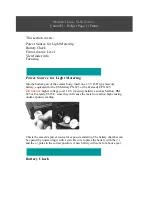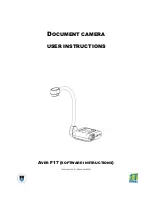
Filters and mounts
175
Goldeye G/CL Technical Manual V4.2.0
Filters
General terms explained
In general, five types of filters are used to filter visible and invisible light waves of
various frequencies.
•
Bandpass filter:
a bandpass filter is translucent for a certain frequency range,
rejecting all frequencies above and below the defined range.
•
Long Pass Filter:
a long pass filter is translucent from a certain frequency
onwards and for all frequencies above it, thus rejecting all frequencies below.
•
Short Pass Filter:
a short pass filter is translucent up to a certain frequency and
for all frequencies below, thereby rejecting all frequencies above.
•
Notch
or
Band
Reject
filter: a notch filter is translucent for all frequencies
above and below a defined range, thereby rejecting all frequencies of that
range. A Band Reject filter can be seen as the opposite of a Bandpass filter.
•
All
Pass
or
Phase
Shift
filter: an all pass filter is equally translucent for all
frequencies, however its function is not to reject any frequencies, but to shift
the phase or time of a signal.
Bandpass filters
The Goldeye responds to wavelengths from about 900 nm to 1800 nm. Using a
bandpass filter, it is possible to restrict the complete bandwidth to a certain range
of wavelengths. That way, only a certain wavelength band is transmitted, all others
are rejected.
The describing characteristics of a bandpass filter are properties like optical
density, or spectral profile. The main characteristics, however, are the center
wavelength (CWL) together with the bandwidth (full width at half maximum,
FWHM) being transmitted.
Bandpass filters can cut the transmitted frequencies more or less sharply.
Accordingly, the increase or decrease in gain at the edges of the translucent
frequency band is more or less steep. This results in certain properties for each
bandpass filter, that are defined by the following terms.
Passband
The passband is the band of wavelengths that the filter allows to pass. Generally,
the passband refers to the range of wavelengths between the
Cut-on
and
Cut-off
wavelengths. Therefore, most often the passband is described using the central
wavelength and the FWHM.
Содержание Goldeye CL Series
Страница 9: ...Read before use 9 Goldeye G CL Technical Manual V4 2 0 JA Intended use 32 Allied Vision Allied Vision...
Страница 13: ...Read before use 13 Goldeye G CL Technical Manual V4 2 0 ZH Intended use 32 Allied Vision Allied Vision B2B...
Страница 245: ...Goldeye G CL Technical Manual V4 2 0 Cleaning optical components This chapter includes instructions on camera cleaning...















































